Baptisia australis
 Baptisia australis
Baptisia australis
(bap-TEE-zsah oss-TRAL-iss)
syn. Baptisia caerulea
Family: Papilionaceae
Common name: blue false indigo; blue wild indigo; plains false indigo
Zone: 4 – 9
Height: 3-4 ft (90-120 cm)
Spread: 3 ft (90 cm)
Aspect: full sun; partial shade
Soil: average; well-draining
Water: moderate
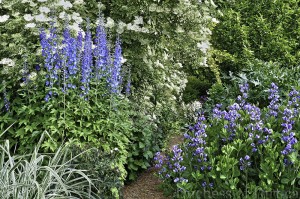 Description: An herbaceous perennial with an upright, arching habit. Attractive blue-green, palmate leaves with inversely lance-shaped leaflets. Deep indigo blue pea-like flowers in racemes on erect spikes appear in June and July. Dark, pea-like seed pods follow in late summer.
Description: An herbaceous perennial with an upright, arching habit. Attractive blue-green, palmate leaves with inversely lance-shaped leaflets. Deep indigo blue pea-like flowers in racemes on erect spikes appear in June and July. Dark, pea-like seed pods follow in late summer.
Special Notes: Native to North America. Plant takes two to three years to establish well and flower. Site well in the garden as this plant is not partial to being moved. May require staking in a windy location. Drought tolerant. Attracts bees and butterflies. Good cut flower. Attractive seed pods are excellent in dried arrangements. May suffer occasional fungal leaf spots, powdery mildew and rust. Propagate by seed; division in spring or autumn.
RHS Award of Garden Merit 1993; Great Plant Pick 2011
In our Zone 7a garden: Patience is a virtue with this plant as it does take the two to three years to establish itself before flowering. But oh, is it ever so worth the wait! As for its purported dislike for being moved once planted…we have not experienced any horrific upset in the Baptisia australis plants we have moved around in our landscape design for one reason or another. Perhaps because we always amend the planting hole with compost or aged manure and add in a very generous helping of our homemade complete fertiliser before planting or transplanting any of our plants.
Posted on September 22, 2012; updated on September 23, 2024
Asphodeline lutea
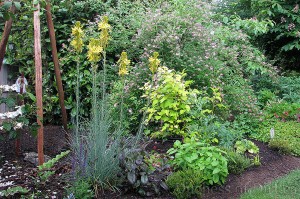 Asphodeline lutea
Asphodeline lutea
(as-foh-DELL-in-ee LOO-tee-ah)
Family: Asphodelaceae
Common name: king’s spear; Jacob’s rod; yellow asphodel; flower of the dead
Zone: 7
Height: 3-4 ft (90-120 cm)
Spread: 1-2 ft (30-60 cm)
Aspect: full sun; partial shade
Soil: fertile; well-draining
Water: moderate
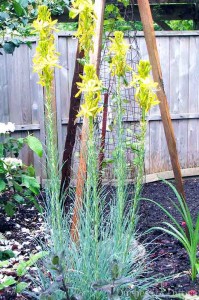 Description: An herbaceous perennial with a clump-forming, slightly spreading habit. Narrow, grass-like, blue-grey-green leaves. Dense racemes of dark yellow, fragrant, star-shaped flowers with large bracts appear in late spring through summer. Propagate by seed; division in spring or autumn.
Description: An herbaceous perennial with a clump-forming, slightly spreading habit. Narrow, grass-like, blue-grey-green leaves. Dense racemes of dark yellow, fragrant, star-shaped flowers with large bracts appear in late spring through summer. Propagate by seed; division in spring or autumn.
Special Notes: Native to southeastern Europe and Turkey. Once used long ago as a medicinal plant. Introduced into England in 1648. Attracts bees and other pollinating insects. Attractive seedheads. Self-sows. Slugs and snails may be a problem for newly emerging shoots in early spring.
Posted on December 17, 2012; updated on January 31, 2013; updated on September 2024
Asclepias tuberosa
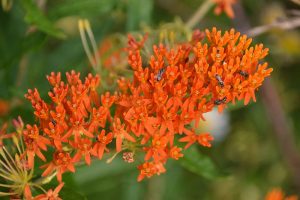 Asclepias tuberosa
Asclepias tuberosa
(ah-SKLEE-pee-us too-ber-OH-sah)
Family: Apocynaceae
Common name: butterfly weed, chieger flower, Indian paintbrush, pleurisy root, white root, windward root
Type: herbaceous perennial
Zone: 4 – 9
Height: 24-36 in (60-90 cm)
Spread: 18-24 (45-60 cm)
Aspect: full sun; part shade
Soil: moderate; poor; well-draining
Water: moderate; minimal
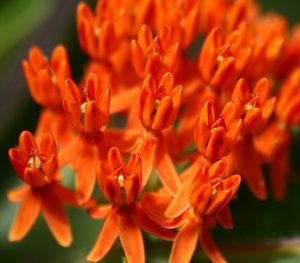 Description: An herbaceous perennial with an erect, clumping habit and a long tap root. Narrow, lance-shaped leaves are green. Vibrant orange-red, umbel-like clusters of small, uniquely-shaped flowers appear atop hairy, milk-less stems in early summer through into autumn. (There can be some flower colour variations ranging from orange to yellow.) Spent flowers give way to 3-6 inch (7.5-15 cm) long, spindle-shaped seed pods which split open when ripe. The numerous, silky-tailed seeds are dispersed by the wind.
Description: An herbaceous perennial with an erect, clumping habit and a long tap root. Narrow, lance-shaped leaves are green. Vibrant orange-red, umbel-like clusters of small, uniquely-shaped flowers appear atop hairy, milk-less stems in early summer through into autumn. (There can be some flower colour variations ranging from orange to yellow.) Spent flowers give way to 3-6 inch (7.5-15 cm) long, spindle-shaped seed pods which split open when ripe. The numerous, silky-tailed seeds are dispersed by the wind.
Special Notes: Native to the eastern regions of North America, stretching to the western borders of Ontario, Minnesota, Iowa, and south to the Gulf of Mexico. One of very few Asclepias species which does not contain the typical milky sap found in other plants in the milkweed family, Apocynaceae. Because of this lack of toxic milky sap, this plant is the major food source for the Monarch and Victoria butterfly larvae. The flowers also lure other nectar-loving insects as each individual small flower produces copious amounts of sweet nectar.
Once upon a time, the dried root of this plant was used medicinally to treat pleurisy, an inflammation of the lungs.
Asclepias tuberosa has a long taproot which precludes its abhorrence to relocation. Best give its destination in your landscape design full consideration before placing it in the ground. If you really must move it, be sure to dig down deeply to ensure you get all of the taproot with the plant. Word to the wise…according to Allan M. Armitage in his book, co-authored with Judy M. Laushman, Specialty Cut Flowers: The Production of Annuals, Perennials, Bulbs, and Woody Plants for Fresh and Dried Cut Flowers (2008), “if you break the taproot when transplanting, it can take two years for the plant to recover, if ever”.
There are no serious insect or disease problems, although the leaves can be susceptible to rust and leaf spot. Of great note…this plant is deer and rabbit resistant. Also drought tolerant, once established.
Propagate by fresh seed in autumn. Seeds need stratification…a period of exposure to winter cold temperatures…of 0.5 – 3 °C (33-38 °F) for at least a month. If buying packaged seeds, place a few seeds (not the whole packet) in the refrigerator for 4 weeks…or in the freezer for 2 weeks…before sowing. Be patient. They may take longer than the typical 7 – 14 days to germinate.
In our Zone 7a garden: We used to have this plant in our garden. However, I suspect John moved this plant, as he is constantly tweaking his landscape design. Allan Armitage’s words of warning have a ring of authority to them because I fear John did not get all of the taproot when he embarked on its transplanting. We sadly no longer have Asclepias tuberosa in our garden.
But…if at first you don’t succeed…try, try again! I will keep you posted.
Posted on January 21, 2017; updated on September 10, 2024
Asarum caudatum
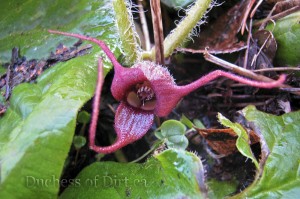 Asarum caudatum Family: Aristolochiaceae
Asarum caudatum Family: Aristolochiaceae
(ah-SAR-um kaw-DAH-tum)
Common name: British Columbia wild ginger; western
wild ginger; long-tailed wild ginger
Zone: 3 – 8
Height: 5-8 in (12-20 cm)
Spread: 12-18 in (60-75 cm)
Aspect: partial shade; full shade
Soil: moderately fertile; well-draining
Water: moderate
Description: A semi-evergreen perennial with a slowly spreading, ground-covering habit. Kidney-shaped, medium green, glossy leaves show their distinctive veining. Leaf stems are covered in very fine, soft hairs. Cup-shaped, brownish-purple flowers appear in mid-spring. Very distinctive with their petals terminating in long, graceful tails. Look for them laying atop the soil, hidden under the leaves.
Special Notes: Native to the Pacific Northwest. Great ground-cover plant but is slow to establish. Will tolerate some sun. Foliage and roots have a spicy ginger and citrus fragrance when crushed. Relatively pest- and disease-free. Slugs and snails may be a problem in early spring. Deer and rabbit resistant. Propagate by fresh seed; divide in early spring or autumn. Will self-sow.
Great Plant Pick 2006
Posted on April 19, 2013; updated on August 7, 2024
Asarum europeaum
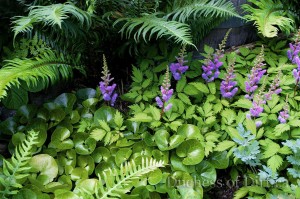 Asarum europaeum
Asarum europaeum
(ah-SAR-um yur-oh-PAY-um)
Family: Aristolochiaceae
Common name: European wild ginger; hazelwort; wild
spikenard; asarabacca
Zone: 3 – 8
Height: 3-6 in (7-15 cm)
Spread: 12-18 in (30-45 cm)
Aspect: partial shade; full shade
Soil: moderately fertile; well-draining
Water: moderate
Description: An evergreen perennial with a slowly spreading, ground-covering habit. Rounded, kidney-shaped, bright green, glossy leaves show their distinctive veining. Leaf stems are covered in very fine, soft hairs. Bell-shaped, brownish-dull purple flowers appear in mid-spring. Look for them laying atop the soil, hidden under the leaves.
Special Notes: Native to Europe. This is a wonderful ground-cover plant but is slow to establish. Be patient. Roots are sometimes harvested for use as a spice or flavouring. Long ago the crushed leaves were used in snuff. Relatively pest- and disease-free. Rust and leaf gall may be a problem in some climates. Deer and rabbit resistant. Propagate by fresh seed; divide in early spring or autumn. Will self-sow.
RHS Award of Garden Merit 2007; Great Plant Pick 2011
Posted on April 18, 2013; updated on August 7, 2024
